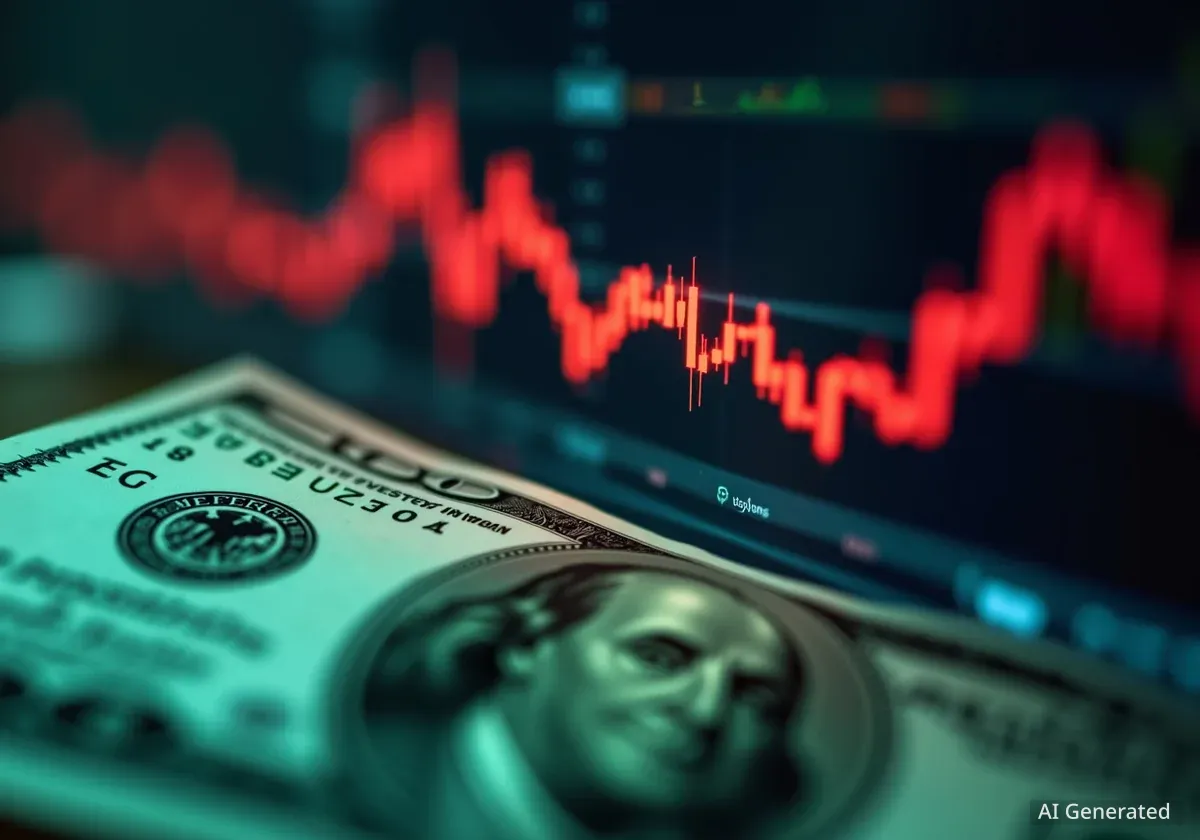The U.S. dollar experienced a significant rally, driven by unexpected upward revisions to second-quarter Gross Domestic Product (GDP) and inflation figures. The new data has prompted a reevaluation of the Federal Reserve's potential interest rate cuts, leading to a sharp increase in Treasury yields and forcing traders with short positions on the dollar to reconsider their stance.
Key Takeaways
- Revised U.S. Q2 GDP growth was reported at 3.8% year-over-year, up from the initial 3.3% estimate, marking the fastest pace since Q3 2023.
- Key inflation metrics, including PCE prices, were also revised higher, raising questions about the timing of future Federal Reserve rate cuts.
- U.S. Treasury yields rose sharply in response, with the 2-year yield increasing by 7.3 basis points.
- The U.S. Dollar Index (DXY) strengthened significantly as traders who were betting against the dollar were forced to cover their positions.
- Major currencies like the Japanese yen, euro, and British pound weakened considerably against the dollar.
Economic Data Revisions Spark Market Shift
Typically, final GDP releases do not cause major market movements, but Thursday's report for the second quarter proved to be a notable exception. The Bureau of Economic Analysis revised the annual growth rate to 3.8%, a substantial increase from the previously reported 3.3%.
This revision indicates that the U.S. economy was more robust than initially thought. The underlying components of the report showed strength in consumer activity. Consumer spending was adjusted upward to 2.5% from 1.6%, and sales figures were lifted to 7.5% from 6.8%.
Why Revisions Matter
Economic data is often released in several stages: advance, preliminary, and final. Revisions occur as more complete data becomes available. A significant upward revision, like this one, can change the market's perception of economic health and influence central bank policy expectations.
Inflation Figures Add to Upward Pressure
Adding to the dollar's strength were revisions to key inflation indicators for the same period. The Personal Consumption Expenditures (PCE) price index was revised to 2.1%. More importantly, core PCE, which excludes volatile food and energy prices and is closely watched by the Federal Reserve, was adjusted to 2.6%.
Another metric, known as super-core inflation, was reported at 2.4%. These higher figures suggest that inflationary pressures were more persistent in the second quarter than earlier data suggested, complicating the outlook for monetary policy.
Bond Yields Climb as Rate Cut Bets Fade
The stronger economic data immediately impacted the U.S. bond market. Investors sold government bonds, causing their prices to fall and yields to rise. The yield on the 2-year Treasury note, which is highly sensitive to Fed policy expectations, jumped 7.3 basis points (bp) to 3.6%. According to market analysts, this move was more than double its average daily change over the past year.
Longer-term yields also increased. The 10-year Treasury yield climbed 9.3 basis points, while the 30-year yield added 9.5 basis points. This broad-based rise in yields made holding U.S. dollars more attractive to investors, further boosting its value.
The probability of a Federal Reserve rate cut in November, as priced by Fed funds futures, dropped from near-certainty to 85% following the data release. The odds for a December cut also fell to 60%.
The market is now scaling back expectations for how aggressively the Federal Reserve will cut interest rates in the coming months and into 2026. This recalibration is a direct response to the resilient economic growth and stickier inflation data.
Broad-Based Dollar Strength Across Currency Markets
The U.S. dollar emerged as the strongest-performing major currency, gaining ground against all its primary rivals. The rally was fueled by a combination of new long positions and a significant amount of short-covering, where traders who had bet on the dollar's decline were forced to buy it back to limit their losses.
Several key currency pairs saw significant moves:
- USD/JPY: The Japanese yen weakened for a second consecutive day, allowing the pair to break out of a 38-day trading range. Traders are now watching the 150 level as a potential next target.
- EUR/USD: The euro slid below the 1.17 mark against the dollar, recording its second straight daily loss of approximately 0.6%.
- GBP/USD: The British pound underperformed the euro, falling to a 36-day low against the dollar. This weakness also pushed the EUR/GBP cross to a 44-day high.
- NZD/USD: The New Zealand dollar was the weakest major currency, breaking below the 0.58 level to reach a 5-month low as expectations for a rate cut from the Reserve Bank of New Zealand grew.
- USD/CAD: The dollar gained against its Canadian counterpart for the fourth day, reaching an 18-week high.
Trader Positioning and Technical Outlook
Recent data on trader positioning suggests many were caught off guard by the dollar's sudden strength. According to the latest Commitment of Traders (COT) report from the Commodity Futures Trading Commission (CFTC), large speculators and asset managers held significant net-short positions on the U.S. dollar index (DXY).
"Large speculators more than doubled their net-short exposure last week, largely due to heavy long liquidation, taking bearish positioning to a four-year high," noted market analyst Matt Simpson in his original analysis. This indicates that many institutional traders were positioned for a weaker dollar.
US Dollar Index (DXY) Analysis
From a technical standpoint, the U.S. Dollar Index found strong support around the 96.00 level, an area that has acted as a floor for prices multiple times since 2023. The current rebound is viewed as a countertrend rally.
While a full reversal seems unlikely given the Federal Reserve's reluctance to consider rate hikes, the short-covering pressure could push the index higher. Key resistance levels to watch are the 50-week Exponential Moving Average (EMA) near 99.87 and the psychological 100.00 mark. A sustained break above this area could open the door to a move toward the 102.00 level.
Despite the current rally, the broader context, including political pressure for rate cuts, suggests that these gains may be corrective rather than the start of a new long-term uptrend for the dollar.
Upcoming Economic Events
Traders will be closely watching a series of important economic data releases in the coming days to gauge the next direction for markets. Key events include:
- Japanese CPI Data: Inflation figures from Tokyo will be critical for the Bank of Japan's policy outlook and the yen.
- U.S. Core PCE Price Index: The Federal Reserve's preferred inflation gauge for August will be a major focus, providing more insight into price pressures.
- Speeches from Central Bankers: Remarks from ECB President Christine Lagarde and FOMC Member Barkin could provide new clues on monetary policy.
- Canadian GDP Data: Growth figures from Canada will influence the direction of the USD/CAD pair.
These events will be crucial in determining whether the dollar's recent strength can be sustained or if it was a short-term reaction to revised data.





